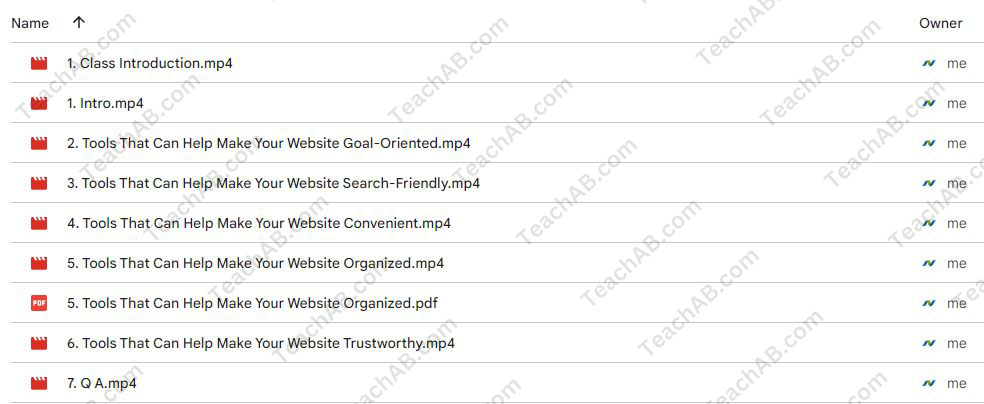Elevate Your Website with Google Tools By Anna Lee Grymes & Basim Newby – Google
$5.00
Elevate Your Website with Google Tools By Anna Lee Grymes & Basim Newby – Google – Immediate Download!
Content Proof:

Elevate Your Website with Google Tools
In today’s digital era, the online landscape is more competitive than ever. Every website has to find a way to stand out, to be seen, and to capture the attention of potential users or customers. Enter the comprehensive guide on elevating your website with Google tools, authored by Anna Lee Grymes and Basim Newby. This resource acts as a navigational compass for individuals and businesses looking to optimize their online presence.
The focus is on using various Google tools to transform not just the performance of a website but also its visibility in search engines. Let’s delve into the essential components of this guide and uncover how these tools can work harmoniously to enhance your website’s effectiveness in the vast online marketplace.
Understanding the Google Search Console
The Google Search Console is akin to a lighthouse in a foggy night for website owners. It illuminates paths towards understanding how Google perceives your website, allowing you to steer your digital ship away from potential pitfalls. This powerful tool provides immediate insights into various aspects such as search traffic metrics, indexing issues, and more. For instance, by regularly checking the console, users can identify and rectify any errors that may hinder search engine visibility.
One of the highlights of utilizing the Search Console is its ability to help monitor the performance of various pages on your site. The tool offers valuable data including click-through rates, impressions, and average positions for your keywords. This in-depth analysis can yield opportunities to tailor your content more effectively to the interests of your audience. Imagine being able to fine-tune your website based on real-time data rather than gut feelings this is the precision that Google Search Console affords its users.
Moreover, the Search Console serves as an essential tool for ensuring your site is adequately indexed by Google. This process involves not just submitting your sitemap but also monitoring any crawl errors that might arise. A well-indexed website can significantly improve its chances of ranking higher in search results, akin to having a prominent billboard on a busy highway rather than a hidden alley. Thus, leveraging the insights gained from this tool can ultimately propel your website towards higher traffic and increased visibility.

Table 1: Key Features of Google Search Console
| Feature | Description |
| Performance Analysis | Insights on clicks, impressions, and keyword rankings. |
| Indexing Status | Monitor how well your site is indexed by Google. |
| Error Reporting | Identify and fix crawl errors that impede visibility. |
| Sitemap Submission | Easily submit and manage your website’s sitemap. |
Mobile Usability A Non-Negotiable
As we navigate through the digital waters, one critical fact stands out: over 70% of shoppers use their mobile devices for online purchases. This underscores the necessity of optimizing for mobile usability. Tools like the Mobile-Friendly Test by Google are indispensable in assessing how friendly your website is for mobile users. Simply put, if your website isn’t mobile-optimized, you’re likely alienating a significant portion of your audience.
Mobile optimization can sometimes feel like fitting a square peg into a round hole, especially when trying to condense content and functionality for smaller screens. However, with the right strategies, this challenge can be transformed into an advantage. Mobile-optimized websites not only provide a better user experience but also rank higher in search engine results, as Google prioritizes mobile-first indexing.
In practical terms, a mobile-friendly website often entails responsive design, fast loading speeds, and touch-friendly interfaces. By investing effort into translating your desktop site into a mobile-optimized version, you create a seamless experience that engages users from their first visit. Studies have shown that when businesses optimize their sites for mobile, they see an increase in both user engagement and conversion rates. This correlation between mobile optimization and user interaction is not merely theoretical; it’s backed by data, making a compelling case for prioritizing mobile usability.
List of Benefits of Mobile Usability
- Enhanced User Experience: Facilitates easier navigation and interaction on smaller screens.
- Improved SEO Ranking: Google rewards mobile-friendly sites with favorable rankings.
- Increased Conversions: Customers are more likely to purchase from mobile-optimized sites.
- Broader Reach: Engages a larger audience who predominantly use smartphones for browsing.
Comprehensive SEO Strategies
To achieve the ultimate transformation of your website, a comprehensive approach to SEO is paramount. This includes adopting targeted keyword strategies and conducting meticulous on-page optimizations. It’s fascinating to think of keywords as threads in a grand tapestry; each thread contributes to the overall narrative and attracts specific groups of visitors to your site.
By utilizing tools such as Google Analytics in conjunction with a well-devised SEO strategy, users can track behavior patterns and adapt their content accordingly. Understanding how visitors navigate through your pages allows website owners to create content that resonates with their audience. This process is less about static keywords and more about engaging storytelling ensuring that each piece of content adds value while optimizing for discoverability.
The amalgamation of keyword research and competitive analysis can reveal hidden opportunities in your niche. This involves monitoring competitors, understanding their SEO strengths and weaknesses, and leveraging that information to position your content strategically. Such insights can be the difference between being a small pebble on the beach or a striking diamond nestled within the sand.
Summary Table: SEO Strategies
| Strategy | Description |
| Targeted Keyword Research | Identifying relevant keywords to drive traffic. |
| On-Page Optimization | Enhancing meta tags, headers, and content structure. |
| Competitor Analysis | Examining competitors’ strengths to inform strategies. |
| User Behavior Tracking | Using analytics to understand visitor navigation patterns. |
Analytics Tracking What Matters
The importance of analyzing user behavior cannot be overstated. Google Analytics provides a treasure trove of information that can illuminate the dark corners of website performance. By tracking metrics such as page views, bounce rates, and session durations, you can connect the dots between user interactions and overall site effectiveness.
Embracing data-driven strategies means making informed decisions rather than flying blind. For instance, if you notice a high bounce rate on a specific page, it could indicate that your content isn’t resonating as intended; perhaps it lacks depth or fails to meet visitor expectations. In such scenarios, adjustments can be made be it improving the content, enhancing visual appeal, or even rethinking the call to action.
Additionally, by segments categorizing users by demographics or behavior you can further tailor your content to specific audiences. Imagine creating tailored experiences for different types of visitors based on their actions and preferences; this personalization can significantly enhance user satisfaction and encourage repeat visits.
Key Metrics in Google Analytics
- Page Views: Total number of times a page is viewed.
- Bounce Rate: Percentage of visitors who leave after viewing a single page.
- Session Duration: Average length of time users spend on the site.
- Traffic Sources: Identifies where visitors are coming from (organic search, social media, direct).
Conclusion
By harnessing the full potential of Google tools such as Search Console, mobile usability assessments, comprehensive SEO strategies, and robust analytics, website owners can elevate their digital spaces to new heights. This guide, crafted by Anna Lee Grymes and Basim Newby, serves as a vital resource, illuminating the pathways toward improved performance and visibility in a crowded online space. In the end, the promise offered by these Google tools is not just about enhancing website aesthetics or ticking boxes on a checklist; it’s about crafting a user experience that resonates, retains attention, and drives conversions. Welcome to the future of web optimization where every click counts and every insight matters.
Frequently Asked Questions:
Business Model Innovation: We use a group buying approach that enables users to split expenses and get discounted access to well-liked courses. Despite worries regarding distribution strategies from content creators, this strategy helps people with low incomes.
Legal Aspects: There are many intricate questions around the legality of our actions. There are no explicit resale restrictions mentioned at the time of purchase, even though we do not have the course developers’ express consent to redistribute their content. This uncertainty gives us the chance to offer reasonably priced instructional materials.
Quality Control: We make certain that every course resource we buy is the exact same as what the authors themselves provide. It’s crucial to realize, nevertheless, that we are not authorized suppliers. Therefore, our products do not consist of:
– Live coaching calls or sessions with the course author.
– Access to exclusive author-controlled groups or portals.
– Membership in private forums.
– Direct email support from the author or their team.
We aim to reduce the cost barrier in education by offering these courses independently, without the premium services available through official channels. We appreciate your understanding of our unique approach.
Be the first to review “Elevate Your Website with Google Tools By Anna Lee Grymes & Basim Newby – Google” Cancel reply
You must be logged in to post a review.

 Options Trading Workshop On Demand With Affordable Financial Education
Options Trading Workshop On Demand With Affordable Financial Education  Spring Cloud Gateway Resilience and Security by Thomas Vitale
Spring Cloud Gateway Resilience and Security by Thomas Vitale  Pro Indicator Pack With Trade Confident
Pro Indicator Pack With Trade Confident  DS4B 102-R Shiny Dashboards With Matt Dancho
DS4B 102-R Shiny Dashboards With Matt Dancho 










Reviews
There are no reviews yet.